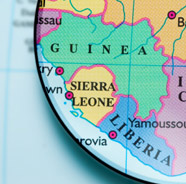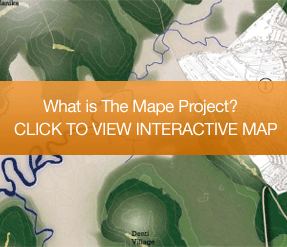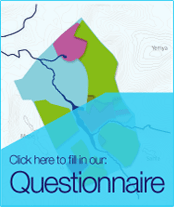
Sierra Leone
Location

Bradt’s Travel Guide for Sierra Leone (by Katrina Manson and James
Knight, First Edition,
May 2009, www.bradtguides.com) observes that Sierra Leone manages to
squeeze beaches, rainforests, mountains, savannah grasslands,
marshes, mangrove swamps and rivers into its relatively small 71,740km2. It sits on the southwest corner
of the West African bulge at a latitude of 8° 30'N, and a longitude of 11° 30'W.
The country is appropriately, shaped like a cut diamond, tapering to a point in the south where coastal and inland borders meet. It runs about 332km north-south and about 304km west-east, bordered to the north and northeast by Guinea, and to the east and southeast by Liberia, with the Mano River forming a natural barrier between the two countries. The beaches and mangrove swamps of the southwest form a coastline of 403km along the north Atlantic coast. Several beautiful and remote islands are found off its coastline.
She is only 6 hours from Europe and within 2 hours from the rest of West Africa.
Geography and History
Salone (as the country is affectionately called by its residents), has two seasons – wet (May to October) and dry (November to April). The hottest months are March and April when temperatures can reach 38°C. Most of the year temperatures range from 27°C to 30°C.
Sierra Leone is home to an amazing variety of flora and fauna including:
- Rare and exotic orchids in Tingi Hills and Bumbuna
- red-flowered locust bean
- rose apple of Eugenia jambos
- black-and-white colobus monkey
- duikers (small antelopes)
- pygmy hippopotami
- leopards
- 630 bird species
Sierra Leone comprises a rich mix of ethnic diversity with 16 different people groups and 23 living languages. English is the official language and Krio is the lingua franca that is widely used by all.
Historically, Sierra Leone is rich with stories and relics from its poignant slave trade past. Used between 1668 and 1807 as the single largest slave trading post in West Africa, Bunce Island still holds the ruins of the slave castles and canons. Freetown, the country’s capital was then established in 1786 as a destination for freed slaves from Britain and later from Nova Scotia. Reminders of that amazing past can still be found throughout the city today.
The history of its indigenous people is one of courage and drama and there are many great heroes and heroines who have left their mark on the country.









